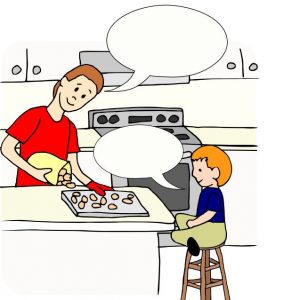 During this unprecented time of social distancing, many of us are eating at home with our families more than before. Cooking together is a wonderful way to work on language goals with your child! Narrate as you plan and cook together. This provides a language model for your child and is a great way to introduce new vocabulary and grammar. For example, “First I am mixing in the eggs, then I will mix in the milk”. Remember to speak in the first person instead of referring to yourself as Mommy/Daddy (e.g., use “I am mixing in the eggs.” instead of “Mommy is mixing in the eggs.”). Meals are also a great time to sit and practice language in a relaxed way. You can download a handout on Supporting Your Child’s Language Skills when Cooking and Sharing Meals and handouts for other activities here.
During this unprecented time of social distancing, many of us are eating at home with our families more than before. Cooking together is a wonderful way to work on language goals with your child! Narrate as you plan and cook together. This provides a language model for your child and is a great way to introduce new vocabulary and grammar. For example, “First I am mixing in the eggs, then I will mix in the milk”. Remember to speak in the first person instead of referring to yourself as Mommy/Daddy (e.g., use “I am mixing in the eggs.” instead of “Mommy is mixing in the eggs.”). Meals are also a great time to sit and practice language in a relaxed way. You can download a handout on Supporting Your Child’s Language Skills when Cooking and Sharing Meals and handouts for other activities here.
Cooking Activities and Strategies
- Before you begin, brainstorm what you want to make, and create a list (written or drawn) of the ingredients you’ll need.
- Flip through a recipe book together or look online. If your child struggles with reading, you can draw a sketch of ingredients and steps. Some food bloggers show photos not just of the finished product, but of each step of the recipe. Many children with language difficulties will appreciate having this visual support.
- Discuss the recipe together before starting. Talk about what you will do first, next, then, or last.
- Talk about where to find the ingredients and utensils needed (e.g. “The mixing bowl is in the drawer.” or “The drawer is under the microwave.”).
- Practice and talk about taking turns when adding ingredients, mixing, etc. Use phrases such as: “Whose turn is it?”, “It’s your turn now.”, “It’s your brother’s turn now”.
- Develop vocabulary by not only labeling objects (e.g., pasta, water, spoon), but also demonstrating action words (e.g., slice, pour, stir), and descriptive words (e.g., slowly, soft, sharp).
- Practice asking and answering wh-questions (e.g. “What do we need next?”, “Where is the bread?”, or “When do we add the salt?”).
- Talk about the quantities of the ingredients you’re using (e.g., “We need more carrots.”) and how they relate to each other (e.g., “This tomato is big, and this one is bigger”).
- Practice understanding and remembering directions. Some children will need short directions (e.g., “Put the lettuce in the bowl.”), and others are ready to work on longer ones (e.g., “Put the lettuce in the bowl, then go get a cucumber and wash it.”). Discuss strategies we use to help us remember and show we understand, such as repeating back what we hear, paraphrasing what we hear, or writing or drawing the information.
Mealtime Activities and Strategies
- Model and practice taking turns. Parents can facilitate turn-taking by looking at their child and directing questions or comments to them.
- Practice asking and answering questions. Remember to use open-ended or wh-questions, not yes/no questions (e.g., instead of asking “Did you like your teacher’s story?”, ask “What happened in the story?”)
- Develop vocabulary using descriptive words:
- Talk about size, color, texture, smell, temperature, and taste (e.g. hot, delicious, crunchy).
- Talk about categories (e.g. ,“This salad has apples, bananas, and melon. They’re all fruits”).
- Practice narratives by talking about how you made the meal, or by telling about things that happened in your day.
- Make use of opportunities to model and practice grammar. If your child produces a short sentence (e.g., “More?”), you can model a slightly longer one (e.g. “More, please?” or “Can I have more, please?”). If your child says something incorrectly (e.g., “Tomorrow I see my teacher.”), you can repeat back correctly what your child should have said (e.g., “Yes, tomorrow you will see your teacher. She will teach you using Zoom”).
Optional websites to explore
How to use cooking to develop your child’s speech and language skills
How to improve communication skills by cooking with kids
Working speech and language skills into mealtime
Top ways to use mealtimes to build a child’s language
Use the above strategies while playing apps
Recipes with visual aids
Recipes with pictorial directions
Free digital downloads for cooking
Recipe for reading comprehension
Leave a Reply